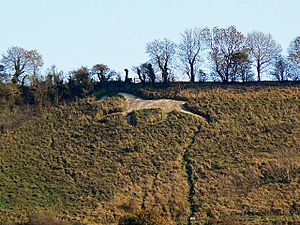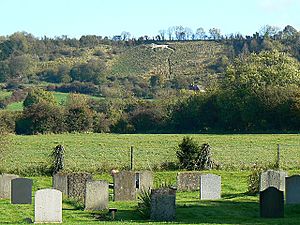Broad Town White Horse facts for kids
The Broad Town White Horse is a giant picture of a white horse carved into a hillside. You can find it in the village of Broad Town, Wiltshire, England. This horse is one of eight famous white horse figures in Wiltshire. It is cut into a steep slope above a farmhouse. You can see it from as far as 20 miles away!
The horse is about 80 feet (24 meters) long and 60 feet (18 meters) tall. It is made from tightly packed white chalk with clear edges. No one is completely sure when it was made. But, a writer named Rev. Plenderleath said in 1885 that William Simmonds carved it in 1864. Simmonds owned the farm at that time. He wanted to make the horse even bigger over the years. However, he had to leave the farm before he could do this.
The white horse is a special symbol for Broad Town village. Many people think it looks like the most lively white horse in Wiltshire. It is easy to spot from far away. Yet, it is also called the "secret white horse." This is because it is in a quiet, rural area away from main roads. Over time, the horse often became overgrown with grass. Keeping it clean and visible was a challenge. Then, in 1991, local villagers formed the Broad Town White Horse Restoration Society. They have been taking care of the horse ever since.
Contents
What is the Broad Town White Horse Like?
The Broad Town White Horse faces west. It is carved on a long, grassy, 45-degree slope. This slope is about 450 meters above sea level. It sits above the Little Town Farmhouse. The farmhouse is about half a mile outside Broad Town village. The hill where the horse is carved used to be part of the farm.
This horse is 60 feet (18 meters) tall and 80 feet (24 meters) long. It is made of fine, packed chalk. It is the third smallest of the eight famous white horses in Wiltshire. The Broad Town horse is also very close to Swindon, just like the Hackpen White Horse.
How Does the Horse Look?
Many people believe this horse is the most active of all the Wiltshire white horses. Writers have called it a lively, "trotting horse." You can see it best from the Little Town farm track, the B4041 road, and Broad Town village itself. The horse is visible for about 20 miles. Because it is on a steep 45-degree slope, you can see it very well from the Great Western Railway line near Swindon.
Writer Paul Newman calls the horse a "conspicuous landmark." But some people find it hard to spot. One writer called it "the secret white horse." They said it was hard to find and even harder to see. Barry Leighton of the Swindon Advertiser agreed. He said the Broad Town horse was "enigmatic." This means it was mysterious. You had to be quick to see it as it popped in and out from behind bushes and trees.
Visiting the White Horse
Visiting the Broad Town white horse can be a bit tricky. There are no special parking spots for it. It is best to park your car in the village. Then, you can walk to the horse from there. A footpath from the farmhouse goes up to the white horse. However, it has dangerous steps. The Broad Town White Horse Restoration Society asks visitors not to use these steps. The society only uses them for maintaining the horse. Since it is private land, they cannot be responsible for accidents. You can also reach the horse using footpaths on top of the hill. But parking is still a problem with this route.
When Was the Broad Town White Horse Made?
The exact origin of the Broad Town White Horse is not certain. There are a few different stories about how it started. The most common story comes from Reverend Plenderleath in 1885. He wrote that William Simmonds cut the horse in 1864. Simmonds owned the land and Littletown Farm at that time. The horse was part of his farm.
According to this story, the horse was first 86 feet long and 61 feet tall. But Simmonds did not want it to stay this size. He planned to make it bigger bit by bit each time he cleaned the horse. So, every time he worked on it, the horse would grow. He wanted it to become "really impressive." He planned to do this by making the horse's outline larger. However, writer Esther Smith, who wrote White Horses of Wiltshire & Uffington, said this might not have worked well. For example, the neck could not be made longer without moving the head. Simmonds did not own the farm long enough to make the horse much bigger. Smith wrote, "We have been spared the sight of a very distorted figure with a short neck and thick legs."
Other Ideas About Its Age
In 1919, a curator from the Imperial War Museum told a local newspaper something different. He claimed he visited the horse as a schoolboy in 1863. He and a friend spent hours cleaning the horse. He also said an older relative told him the horse had been there for at least fifty years. It is possible he mixed up the Broad Town horse with another one. But if his story is true, then Simmonds only fixed up the horse, rather than creating it.
Another less clear story says the horse was cut in 1896 by a Mr. Hussey, Horsey, or Horsley. But Smith thinks this was probably just a time when the horse was recut after being neglected. Another idea is that the horse's design looks older than 1864. Some even suggest it might have been carved in 1865. This could have been to celebrate the birth of Prince George. He later became King George V. Church bells rang and salutes were fired across the country in 1865 for his birth.
History and Care of the Horse
During World War II, the horse was hidden very well. This was to stop German planes from seeing it. Workers used hedge trimmings covered with turf and soil to camouflage it. When the horse was uncovered in 1945, it was not in good shape. Throughout its life, the horse often became so overgrown that you could barely see it. In fact, a book from the 1980s about Wiltshire's white horses said this horse was "now invisible."
In early 1991, the village did a survey. Over 90% of Broad Town's people wanted to help restore and clean the white horse. So, the Broad Town White Horse Restoration Society was formed. They used money from community grants and funds raised by villagers. They put over 180 tons of chalk onto the horse. Then, they added lime to make it bright white again. This made the horse look "perky and playful" once more. The hill is very steep, so metal stakes were put in place to hold the chalk. The restoration of the horse was a big local news story. Both newspapers and television covered it.
Keeping the Horse Clean
The society is made up of local villagers. They continue to regularly restore and scour the horse. Dr. Mark Hows said they "intend to make sure that the Horse will be well maintained." This way, it will stay a well-known local landmark. The horse is trimmed and weeded twice a year. This keeps its outline and shape clear.
A recent cleaning of the horse happened on June 14 and 15, 2014. Bob Clarke, a local archaeologist, led the work. They used over a tonne of powdered lime to make the horse white again. When it rains, the lime powder turns into a hard crust. This "gives the horse another year of life."
The Horse as a Village Symbol
The white horse is a symbol for the village. Barry Leighton said the horse has been a "dazzling emblem or logo for the village below" for over a century. The horse is even in the logo for the village's primary school. It was also stitched into an altar cloth for the school.
In 2015, wildlife artist Joanna May gave her painting of a hare next to the white horse to a Devizes charity auction. She said, "Wiltshire is loved for being the area of the White Horse and also for the hare being synonymous with it." The white horse is part of several tours. This includes the 90-mile walking tour called 'Wiltshire's White Horse Trail'. This trail visits all eight of the famous white horses in Wiltshire. The Wiltshire Tourism board created this tour in 2000.
Images for kids







